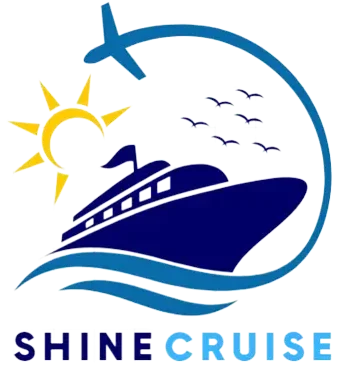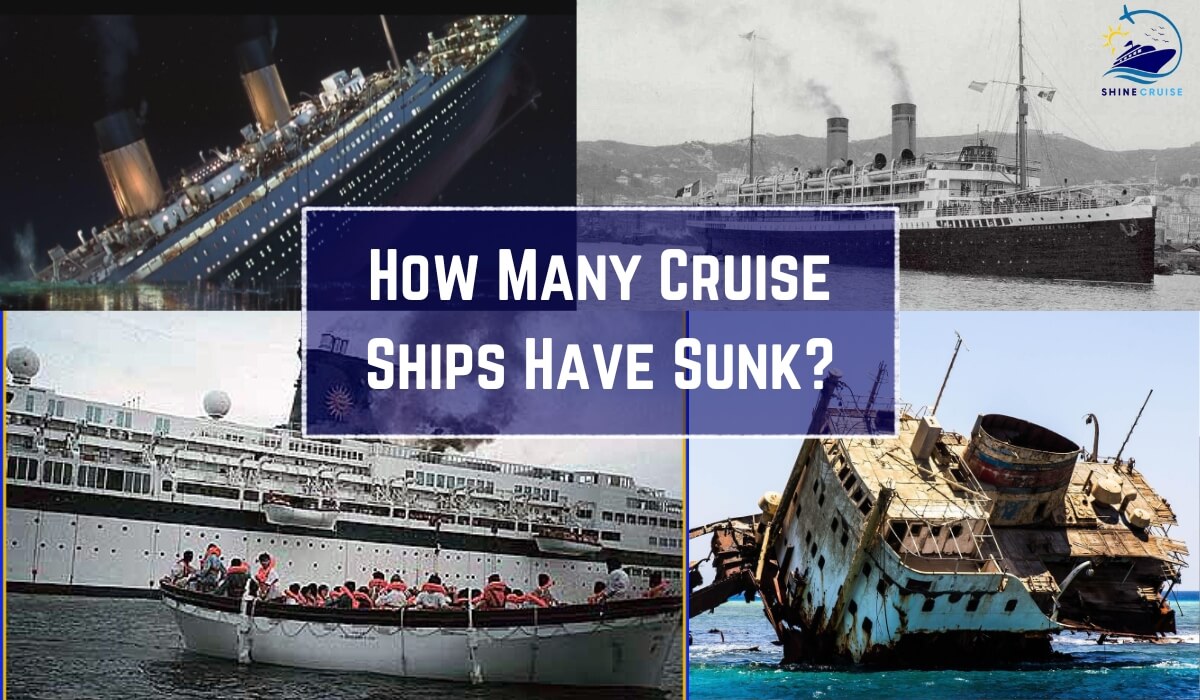Have you ever looked out at the big ocean from a cruise ship and wondered how it stays floating? Cruise ships today are seen as amazing feats of technology, with top-notch safety features that make them very safe to travel on. But behind the fancy amenities and smooth sailing, there’s a history of tragic events. People often wonder, Has a Cruise Ship ever sunk?
The idea of a huge ship sinking invokes both curiosity and fear. Looking into the past of ships at sea reveals a captivating story of successes and disasters.
Let’s explore the history of these maritime legends to find How many cruise ships have sunk ever since.
How Many Cruise Ships Have Sunk?
Here is the list of cruise ships that sinks in the past:
Titanic in April 1912
The Titanic sank after hitting an iceberg on 14 April 1912, on its first voyage across the Atlantic Ocean. The ship sank in about two-and-a-half hours. The collision caused holes in the ship’s hull, leading to flooding in five compartments. This caused the Titanic to sink early on April 15, 1912. There were 2,224 people on board, and around 1,500 died.

The Titanic had 20 lifeboats with a total capacity of 1,178 people, which was only enough for about half of those on board. This lack of lifeboats contributed to the high death toll. Other factors included the ship’s speed in icy conditions, lack of binoculars for lookouts, failure to relay ice warnings and inadequate crew training for emergencies.
The Titanic disaster led to improvements in maritime safety, such as having enough lifeboats for everyone, 24-hour radio monitoring, and the creation of the International Convention for the Safety of Life at Sea (SOLAS) on Modern Cruise Ships.
Empress of Ireland in May 1914
The Empress of Ireland sank due to a collision with another ship, the Norwegian Collier SS Storstad, in thick fog. The Storstad struck the Empress on her starboard side, creating a big hole in the Empress, leading to flooding. The ship tipped to one side and sank within 15 minutes just after the crash.
There were 1,477 people on the Empress of Ireland, and sadly, 1,012 of them died. The ship had 42 lifeboats with space for 1,860 people, which was more than enough for everyone onboard. Empress of Ireland followed the rules made after the Titanic accident two years earlier. But the ship sank very fast, giving little time for people to get off.
Many passengers were asleep when the crash happened, so they couldn’t react quickly. The ship’s tilt made it hard to launch lifeboats from one side.
Lusitania in May 1915
The Lusitania was the world’s largest passenger ship owned by the Cunard Line. It sank because a German U-boat called U-20 (submarine) hit it with a torpedo during World War I near the Ireland coast. The ship was hit on its right side and then there was a big explosion.
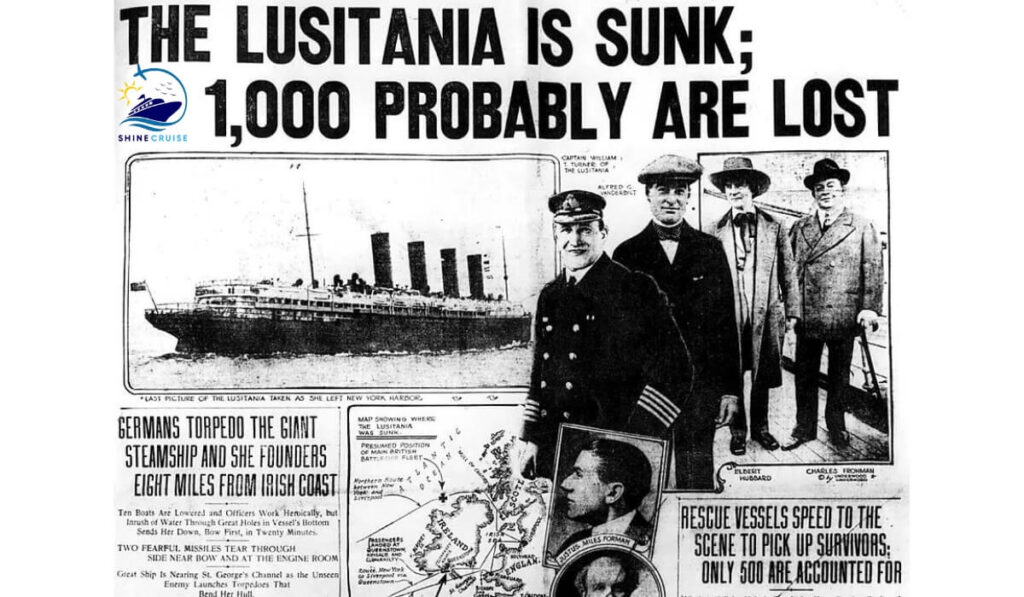
This happened on May 7, 1915, and the ship sank in just 18 minutes. There were 1,959 people on board and 1,198 of them died. The ship had over 40 lifeboats that could hold 2,605 people, but only six were able to be used because the ship sank quickly and was leaning to one side.
Britannic in November 1916
The Britannic was the sister ship of the Titanic and the Olympic and built as a passenger ship for the White Star Line but was turned into a hospital ship during World War I. Britannic sank after hitting a naval mine near the islands of Makronisos and Kea in Greece. The sinking happened on 21 November 1916 and sank in 55 minutes.
The cause of sinking is debated, but it’s thought that the explosion and flooding through open portholes and faulty watertight doors played a role. The ship had nearly 1,060 people on board, mostly crew and medical staff. Despite sinking quickly, only 30 people died.
Most deaths occurred when two lifeboats were released too early and got caught in the ship’s propellers. The Britannic had 55 lifeboats, more than the Titanic, with a capacity for 3,600 people.
Factors that helped keep the death toll low included higher watertight bulkheads, improved evacuation procedures, good weather, calm seas, proximity to land, and the captain’s decision to ground the ship.
Principessa Mafalda in October 1927
The Principessa Mafalda, an Italian ship owned by Navigazione Generale Italiana (NGI) sailed between Buenos Aires and Genoa in 1909. She sank on October 25, 1927, due to a broken propeller shaft that caused a hole in the hull. The engine room flooded quickly, leading to the ship’s sinking. Before the incident, there were issues with the ship’s boilers.

There were 1,252 people on board. About 314 people, including passengers and crew, lost their lives. The ship had lifeboats, but not enough for everyone, which was common for ships of that time.
During the evacuation, there was panic and chaos. Some lifeboats were in poor condition and hard to launch. The ship listed severely, making it difficult to launch lifeboats from both sides.
Crew members reportedly abandoned ship before assisting all passengers. The disaster happened at night, complicating rescue efforts. Several ships, like the Empire Star, Formosa, Alhena, Baden and the Rosetti responded to distress calls and helped rescue survivors.
Saint-Philibert in June 1931
The Saint-Philibert was run by a local French shipping company called Compagnie Nantaise de Navigation Vapeur in Nantes. It was a small cruise ship that sailed around the Loire River and the French coastline in the summer.
The ship sank because it was carrying too many passengers, faced bad weather, had design issues, and water got inside. This caused it to overturn and sink quickly on June 14, 1931.
The ship was carrying around 500 people on board, which was 70% more than its usual capacity. Only 8 people survived, about 492 people died. It’s not clear how many lifeboats were on the ship, but it probably had very few.
The ship was too small for rough seas, and many passengers were on the top deck, making it unstable. When it capsized, there wasn’t enough time to use the lifeboats. The disaster happened near the shore, but the rough conditions made rescue hard.
Georges Philippar in May 1932
The Georges Philippar was a ship owned by a French company called Messageries Maritimes. It sank because of a fire that started in a first class cabin and quickly spread throughout the ship. The fire began on May 16, 1932, and the ship sank the next day.
There were 767 people on board, and around 54 people died in the disaster. Most deaths occurred during the fire and evacuation. The ship was required to have enough lifeboats for everyone on board but launching them was difficult due to the spreading fire.
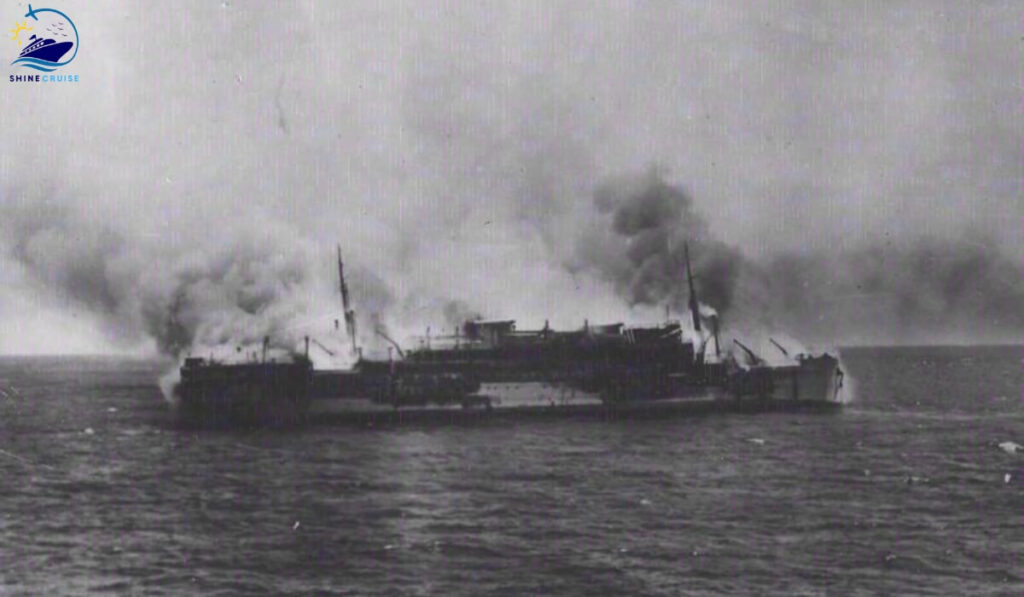
Several factors contributed to the disaster: the ship’s wooden interiors and varnished surfaces fueled the fire, malfunctioning fire doors worsened the situation, the electrical system failed, causing darkness and hindering evacuation, some passengers drowned after jumping overboard, and the evacuation was disorderly with some lifeboats leaving before being full.
SS Morro Castle in September 1934
The SS Morro Castle was a ship operated by the Ward Line, an American company that traveled to New York City from Havana, Cuba. The ship didn’t sink but was destroyed by a fire that started in a storage area on September 8, 1934.
The exact cause of the fire is unknown, but it may have been due to electrical problems, arson, or chemicals catching fire. The fire quickly spread through the ship because of its wooden structure and strong winds. The ship ran aground near Asbury Park, New Jersey, on September 9, 1934.
There were 549 people on board and 137 died including passengers and crew. Many died from fire, smoke, or drowning. Although the ship had enough lifeboats for everyone, only 6 were launched due to the spreading fire and chaos.
Empress of Britain in October 1940
The Empress of Britain was a ship owned by the Canadian Pacific Steamship Company, launched in 1930. It was the biggest British merchant ship lost during World War II due to enemy attacks.
The ship was bombed by German planes on October 26, 1940, causing a fire and significant damage. It was later torpedoed by a German submarine on October 28, 1940.
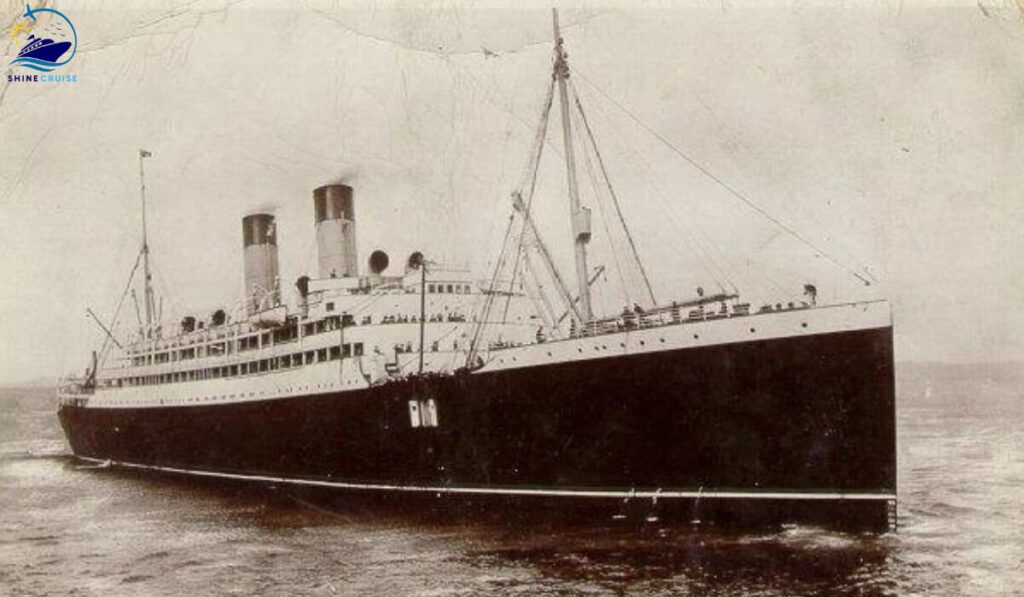
The Empress of Britain was being used to transport troops at the time of the attack. There were 416 crew members, 2 gunners, and 205 passengers were on board including military personnel and their families. 45 died during the initial air raid but the majority survived.
The ship had many lifeboats as it was a large liner converted for military use. Despite the attack, the evacuation was mostly successful, with low casualties.
Andrea Doria in July 1956
The Andrea Doria was operated by the Italian Line (Italia di Navigazione). It sank after colliding with the MS Stockholm, a Swedish American Line ship. The collision happened because of dense fog, radar signal confusion, and confusion about right-of-way rules.
The Stockholm hit Andrea Doria’s side, causing a big hole. This led to flooding, tipping, and sinking of the ship. The collision occurred on 25 July 1956 and the ship sank the next morning.
There were 1,706 people onboard but only 46 died because of successful rescue operations. The crew used better communication systems and training. They saved 1,660 passengers and crew.
The Andrea Doria had 16 lifeboats for 1,834 people but only half could be used because of the ship’s tilt. It took 11 hours for the ship to sink, giving time for rescue.
Bianca C in October 1961
The Bianca C is a special ship because it sank two times. It was first sunk by the Germans in World War II. Later, it was raised and turned into a cruise ship. Costa Line, now Costa Cruises, bought it and named it Bianca C.
The ship sank because of a fire and explosion in the engine room that started in the boiler room. The fire quickly spread, causing the ship to tilt and eventually go underwater. This happened on 22 October 1961 and the ship sank two days later.
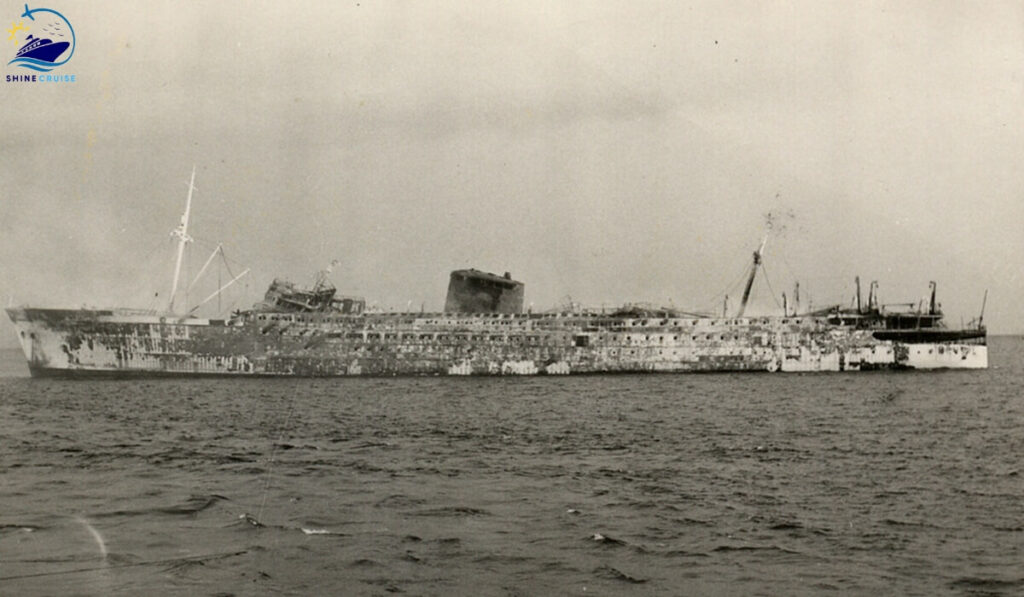
There were around 673 people on board and surprisingly not many lives were lost. Only one crew member died from the explosion, and two passengers later died from heart attacks, possibly due to the stress of the evacuation.
It’s not clear how many lifeboats were on the ship but there seemed to be enough for everyone based on the successful evacuation. The ship was near St. George’s, Grenada when the fire started. Local fishermen and boat owners helped rescue passengers and crew by using small boats to take them to shore.
The British frigate HMS Londonderry tried to put out the fire but couldn’t save the ship. After burning for two days, the Bianca C was towed out to sea to prevent it from blocking the port. It sank about 5 miles offshore in deeper water.
Angelina Lauro in September 1979
The Angelina Lauro, formerly known as MS Oranje, was a passenger ferry that was used as a hospital ship during the war. In 1965, she was acquired by Lauro Lines and converted into a cruise ship. While being chartered to Costa Lines Angelina Lauro ship, caught fire on 30 March 1979 while docked in Charlotte Amalie harbor, St. Thomas, U.S. Virgin Islands.
The fire quickly spread and destroyed the ship which later sank while being towed to a scrapyard in Taiwan on September 24, 1979. Despite having around 1,170 people on board, everyone was safely evacuated and there were no fatalities.
The ship had enough lifeboats for all passengers and crew, but most people were evacuated directly to land due to the ship’s proximity to the dock. The fire started when many passengers were on shore in St. Thomas and local authorities and other ships helped with firefighting.
MS Mikhail Lermentov in February 1986
The Mikhail Lermontov, a ship operated by the Baltic Shipping Company from Leningrad (now St. Petersburg). In 1972, the MS Mikhail Lermentov started as an ocean liner and later became a cruise ship.

On 6 February 1986, the ship left Sydney for a two-week cruise to New Zealand. After 10 days into the journey, the ship hit rocks near Cape Jackson. The collision caused a big hole in the ship’s hull, leading to flooding. The ship sank early on February 17, 1986.
There were 738 people on board and only one person, Pavel Zagladimov, a 33-year-old engineer, lost his life. The ship had enough lifeboats for everyone including 8 large motor lifeboats and smaller lifeboats and rafts.
SS Admiral Nakhimov in August 1986
The Admiral Nakhimov operated by the Black Sea Shipping Company, sank after colliding with the Pyotr Vasev near Novorossiysk in the Black Sea. The collision happened due to mistakes in navigation and communication. It occurred on August 31, 1986. The ship sank in about 7 to 8 minutes.
There were 1,234 people onboard, and many lost their lives. Official records say 423 people died, but some think the number could be higher. The exact number of lifeboats on the ship is not known, but it should have had enough for everyone.
The ship sank so fast that there was little time to launch lifeboats. Passengers were trapped in their cabins, and many were asleep when the collision happened, which led to more deaths.
Pyotr Vasev made a big hole in Admiral Nakhimov’s side. Some watertight doors were open, making the flooding worse. The ship lost power right after the crash, causing darkness and chaos. Rescue efforts were hard because of the dark and how quickly the ship sank.
MV Jupiter in October 1988
MV Jupiter, a Greek cruise ship, sank in the port of Piraeus, Greece after colliding with a cargo ship named Adige on October 15, 1988. The collision damaged Jupiter’s hull causing the ship to sink in 40 minutes.
The ship had 400 British students, 84 adults, and 110 crew on board for a week-long Mediterranean study cruise. Only one student, one teacher, and two crew members died, and about 70 others were injured.
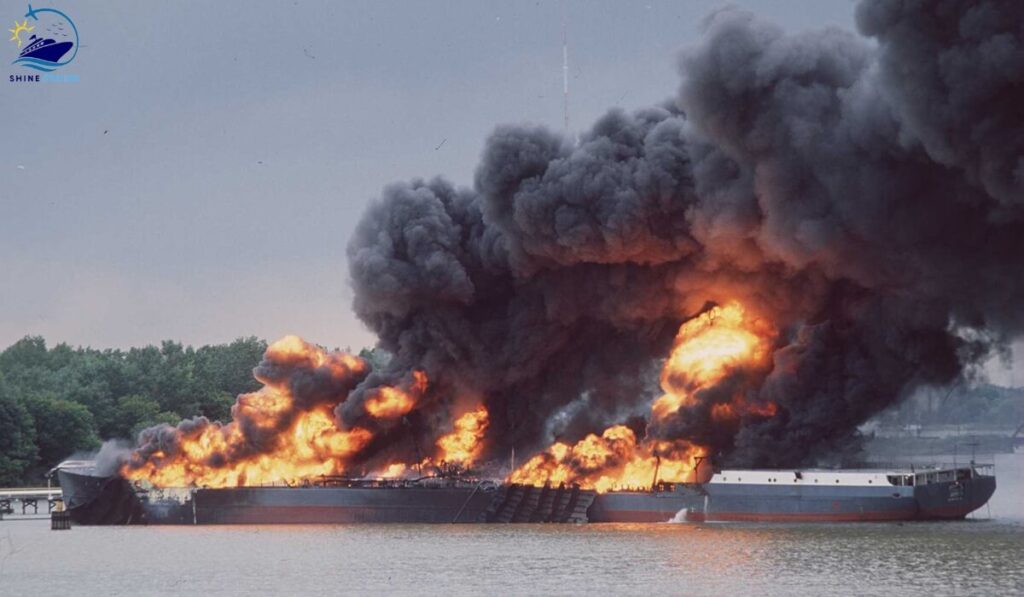
The ship sank after listing heavily to the right side. Greek port authorities and nearby vessels helped in the evacuation with many passengers rescued by small boats and transferred to other ships.
The evacuation was completed in about two hours. MV Jupiter sank completely by the early hours of October 16. The incident prompted a closer look at safety procedures in busy ports like Piraeus.
MTS Oceanos in August 1991
MTS Oceanos was a ship run by Epirotiki Lines, a Greek company that also operated MV Jupiter. The ship sank because water flooded in uncontrollably through a hole in the wall that keeps water out. The flooding started in the engine room because of a broken pump or pipe.
The ship was old, 39 years, and not well taken care of, which made things worse. It sank on August 4, 1991. There were 571 people on board including 402 passengers and 169 crew members. Everyone survived, even though the evacuation was chaotic.
The ship had lifeboats, but the bad weather and the ship leaning made it hard to use them. It’s not clear how many lifeboats there were, but there weren’t enough for the situation. The ship got caught in a big storm off the Wild Coast of South Africa.
The captain and top crew left early, leaving passengers on their own. The entertainment staff, led by cruise director Lorraine Betts and musician Moss Hills, took over the evacuation.
The South African Air Force mainly rescued people by lifting them off the sinking ship. The entertainers used the radio to help with the rescue. It took about 12 hours to get everyone off the ship.
MS Estonia in September 1994
MS Estonia was a cruise ferry operated by Estline, a company from Estonia and Sweden. The ship carried passengers and cars. An investigation found that the ship’s front door broke letting water in and causing it to sink on 28 September 1994. There are different ideas about why it sank.
The ship had 989 people including 803 passengers and 186 crew. 852 people died and only 137 survived, making it one of Europe’s worst maritime disasters in peacetime.
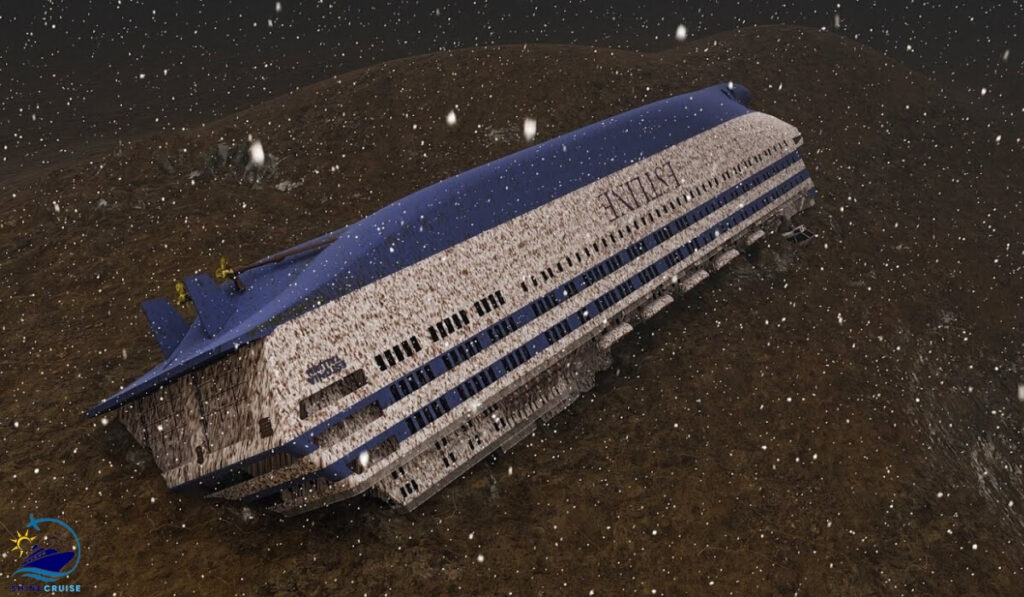
MS Estonia was going from Tallinn, Estonia to Stockholm, Sweden when it sank in the Baltic Sea, near the Finnish island of Ut. Problems started around 1:00 AM when passengers heard loud noises from the front. Many people couldn’t escape when the ship turned over.
MS Achille Lauro in December 1994
The ship MS Achille Lauro, owned by an Italian company called StarLauro, sank because of a fire in the engine room. The fire quickly spread causing the ship to tilt and eventually go underwater. The exact reason for the fire is not certain, but it is believed to be related to electricity or fuel.
The fire started 125 miles off the coast of Somalia while the ship was traveling from Italy to South Africa. The crew tried to put out the fire but couldn’t.
The ship sank on 30 November 1994 with 979 people on board, including 572 passengers and 407 crew members. Two passengers died during the evacuation, one from a heart attack and another who fell into the water and could not be saved. They sent a distress call, and other ships in the area helped with the evacuation.
Most passengers were moved to other ships like the Hawaiian King and Barber Hector. The evacuation took about six hours. Before sinking, the Achille Lauro was hijacked in 1985 by four men from the Palestine Liberation Front, leading to the death of a passenger.
Sun Vista in May 1999
Sun Vista, a ship operated by Sun Cruises, a company owned by Sun Vista Cruises based in Singapore, sank on 21 May 1999 due to a fire in the engine room. The fire caused the ship to lose power leading to flooding and cruise sinking.
There were 1,090 people on board including 472 passengers and 618 crew members. Fortunately, everyone was safely evacuated and there were no fatalities. The ship had lifeboats and life rafts which were crucial in the evacuation. The incident happened in the Strait of Malacca about 11 nautical miles off the coast of Malaysia.
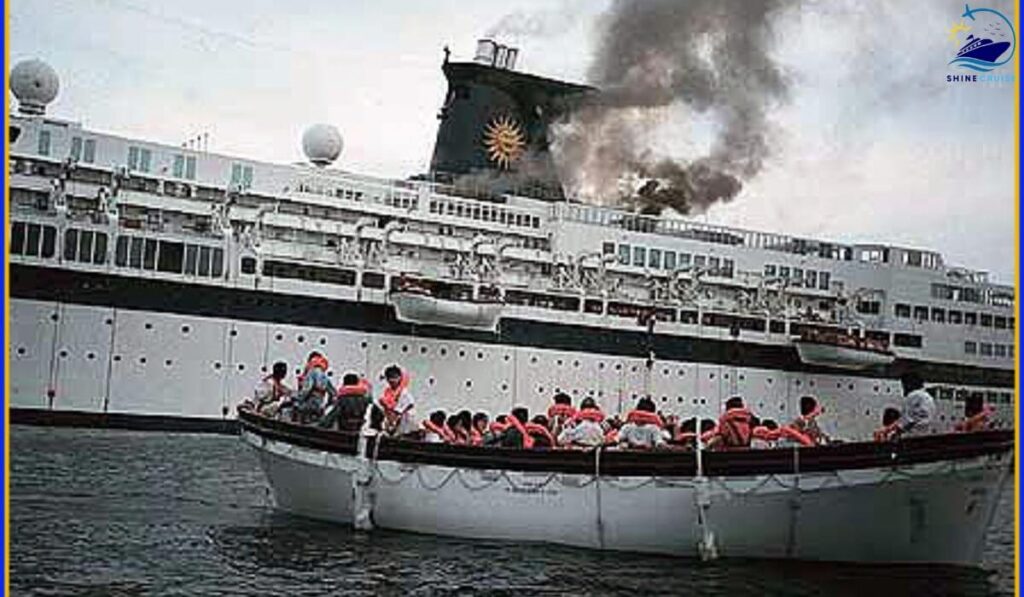
The fire started at 3:00 PM local time, quickly spreading and causing a complete power failure. The captain ordered the evacuation around 6:00 PM. Nearby vessels and local authorities including the Malaysian Maritime Enforcement Agency helped in the rescue operation.
It took about 4 hours to complete the evacuation, and everyone was taken to the Malaysian port of Port Klang.
Britanis in October 2000
Britanis, a ship operated by Celebrity Cruises, sank on 21 October 2000 while being towed to a scrapyard. The ship started taking on water due to its old age and deteriorating condition. Fortunately, there were no passengers or crew on board, so no one was harmed.
Britanis, originally known as SS Monterey had a long history, serving as a cruise ship, troop transport during World War II, and even a floating hotel. It was renamed Britanis in 1970 and retired from active service in 1994.
SeaBreeze in December 2000
Seabreeze started sailing in 1958 for Costa Cruises as Federico C. It moved to Premiere Cruises in 1983. The ship sank in a storm on December 17, 2000.
The ship encountered severe weather with high winds and heavy seas causing it to take on water and sink. Fortunately, there were no passengers on board, only 34 crew members who were all safely rescued.
The ship was on a voyage from Halifax, Nova Scotia to Charleston, South Carolina when it ran into trouble about 200 miles off the coast of Cape Cod, Massachusetts. The crew noticed water entering the engine room around 11:00 PM on December 16. Despite attempts to pump out the water, the flooding got worse, and the ship started to tilt.
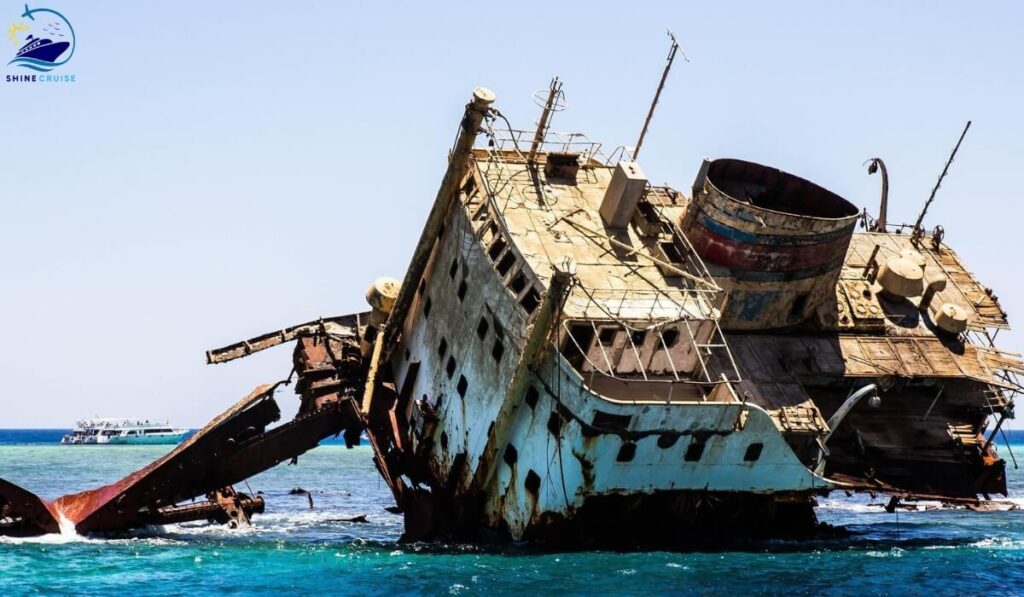
The U.S. Coast Guard was notified and carried out a rescue operation. Due to the extreme weather conditions, helicopter rescue was considered too risky. The crew had to abandon ship around 9:30 AM on December 17 and were saved by the crew of the cargo ship M V Sakura Express, which responded to the distress call.
MV Explorer in November 2007
MV Explorer, a ship operated by G.A.P Adventures (now G Adventures), a Canadian travel company, sank after hitting ice in Antarctica. The collision caused a hole in the hull, leading to flooding that the pumps couldn’t stop.
The ship sank on November 23, 2007. There were 154 people on board including 100 passengers and 54 crew members, but everyone was safely rescued.
The ship had lifeboats and rafts that were important for the evacuation. The incident happened in the Bransfield Strait about 25 miles southeast of King George Island. The ship hit the ice around midnight.
The captain tried to beach the ship on King George Island but had to abandon that plan due to flooding. The order to leave the ship was given around 1:30 AM. Passengers and crew got into lifeboats and rafts in calm seas but cold temperatures.
Norwegian cruise ship “Nordnorge” helped to rescue the survivors. The Argentinian Coast Guard coordinated the rescue. The ship sank completely about 20 hours after the collision. MV Explorer was the first cruise ship made for polar expeditions and was 39 years old when it sank in 2007.
MS Sea Diamond in April 2007
MS Sea Diamond, a cruise ship operated by Louis Hellenic Cruise Lines, ran aground on a reef near the Greek island of Santorini due to a navigation mistake. The hull was badly damaged and despite efforts to save the ship, it sank on April 6, 2007.
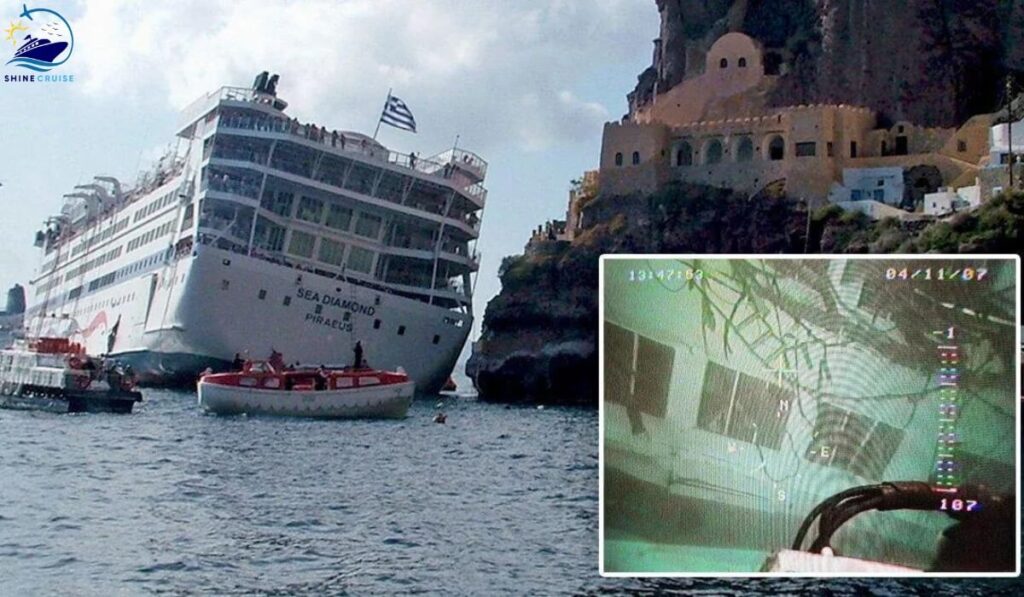
There were 1,195 people on board including 1,154 passengers and 391 crew members. Two passengers, a French father and daughter, were missing and presumed dead. They were believed to be trapped in their cabin during the evacuation.
The ship hit the reef around 6:30 PM on 5 April 2007 near the port of Athinios on Santorini. The grounding was caused by a faulty electronic chart and human error. The captain tried to free the ship but ended up causing more damage.
Most passengers were safely evacuated to the island using lifeboats and local boats. The evacuation took several hours and was finished by midnight.
The ship sank around 7:00 AM on 6 April, less than 200 meters from the shore. Legal action was taken against the captain and 5 crew members for their roles in the accident.
Costa Concordia in January 2012
Costa Concordia, a ship operated by Costa Cruises, a part of Carnival Corporation, partially sank after hitting a rock near Isola del Giglio, Italy. The Costa Concordia cruise ship sinking was due to rock hit, shortly after leaving Civitavecchia. The impact caused a hole in the hull leading to flooding and loss of power.
The captain’s decision to sail close to the island caused the accident on January 13, 2012. There were 4,229 people on board. 32 people died mostly drowning inside the ship.

The captain, Francesco Schettino, downplayed the situation and delayed evacuation. Evacuation started over an hour after the impact with the ship listing heavily to one side. Some people were rescued by helicopter or swam to shore in cold water.
The captain left before all passengers were evacuated, leading to criticism and legal consequences. Captain Schettino was found guilty and sentenced to 16 years in prison. The disaster was one of the worst in cruise ship history impacting the industry’s reputation.
Eastern Star in June 2015
The Eastern Star (Chinese name: Dongfang Zhi Xing) was a Chinese cruise ship that tragically sank in the Yangtze River in China on 1 June 2015. The ship was owned by Chongqing Eastern Shipping Corporation and was built in 1994.
The ship was carrying 456 people, mostly elderly Chinese tourists, when it capsized during a severe thunderstorm while traveling from Nanjing to Chongqing. Only 12 people survived the disaster, making it China’s worst maritime disaster in decades with 442 deaths.
The rapid sinking was primarily caused by strong winds and heavy rain from a powerful cyclone that hit the ship with little warning, causing it to capsize in less than two minutes.
The captain and chief engineer were among the few survivors and were later questioned about their decision to continue sailing despite severe weather warnings. The ship recovered from the river several days later during a massive rescue operation, but most passengers were trapped inside when it capsized.
Orient Queen in August 2020
The Orient Queen was a cruise ship that sank in the port of Beirut, Lebanon, following the massive explosion that occurred there on 4 August 2020. The Orient Queen was a relatively small cruise ship operated by Abou Merhi Cruises, a Lebanese company, and offered Mediterranean cruise itineraries.
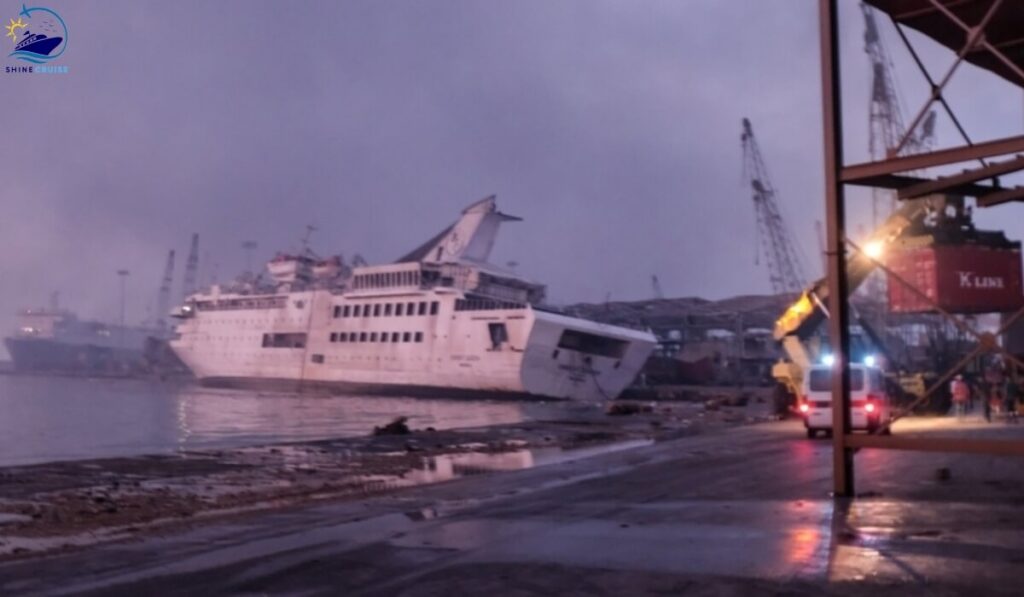
The ship was docked at Beirut’s port when the blast occurred, causing it to partially capsize. Two crew members lost their lives in the incident, while several others were injured.
At the time of the explosion, the ship was not carrying passengers, as cruise operations had been suspended due to the COVID-19 pandemic but had crew members onboard for maintenance.
The force of the Beirut port explosion was so powerful that it severely damaged the vessel, leading to its capsizing and eventually sinking the following day on August 5, 2020.
FAQs – How Many Cruise Ships Have Sunk in 2025
How Many Cruise Ships Have Sunk Since 2000?
Only a few cruise ships have sunk, estimated at 5 to 10 incidents globally since 2000. Examples are the Costa Concordia in 2012 and the Explorer in 2007.
How Many Cruise Ships Have Sunk in the Last 10 Years?
Three cruise ships have sunk in the last 10 years (as of July 2024). These are the Costa Concordia in 2012, the Hableány (a river cruise ship) in 2019, and the Orient Queen in 2020.
How Many Cruise Ships Have Sunk in the Last 5 Years?
Only one cruise ship (Orient Queen 2020) sank in the past 5 years until July 2024. This incident happened in Beirut’s port due to a large explosion, but the ship was not in service at that time.
When was the Last Time a Cruise Ship Sank?
The cruise ship sinking recently happened in the port of Beirut, Lebanon, on August 4, 2020, following a massive explosion in the city’s port area. The ship that sank was the Orient Queen in 2020.
How Often do Cruise Ships Sink in the Ocean?
Cruise ship sinkings are very rare. In the 21st century, only 2 to 3 cruise ships have sunk every 10 years. This means a ship sinks about once every 3 to 5 years worldwide.
How to Survive a Cruise Ship Sinking?
When you board a cruise ship, learn the layout and emergency procedures. If the ship sinks, stay calm, get your life jacket, and follow crew instructions to muster stations. In a lifeboat or raft, stick together, save energy, and wait for rescue.
How Deep is the Titanic Wreck?
The wreck of the Titanic lies 12,500 feet (3,800 meters) below the surface of the North Atlantic Ocean. This is about 2.37 miles (3.81 kilometers) deep. The ship rests on the ocean floor in two main pieces, with the bow and stern sections separated by about 2,000 feet (610 meters).
- Royal Caribbean Cafe Promenade Menu 2026 Review & Tips - December 27, 2025
- MSC Theme Nights 2026 Schedule for All Ships - December 25, 2025
- Carnival Theme Parties & Nights 2026 Schedule for All Ships - December 25, 2025
